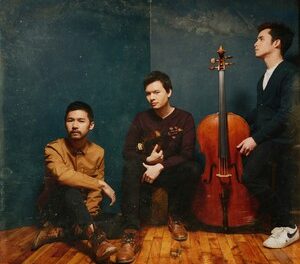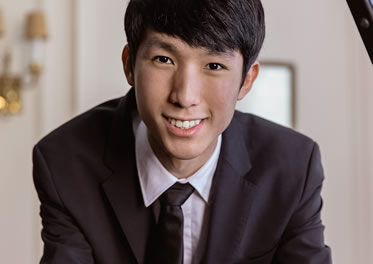The Durham Symphony Orchestra returned with its first live performance in two years and five days (since the pandemic shutdowns began) with a splendidly decorated holiday celebration at the Durham Armory, a delightfully versatile hall that was set up banquet-style for hors d’oeuvres, desserts, drinks, and a silent auction alongside cheery holiday music. Students from United Strings of Color performed pleasant pre-show chamber works as guests found tables, bid on silent auction items, and geared up for the orchestra concert. Rocky Top Catering and Melanated Wine had limited offerings, but they were of good quality. The general atmosphere was warm, friendly, and festive – with poinsettia centerpieces that were for sale, assorted sweets, and lots of fun red accessories on décor and guests alike.
Emcee Anthony Wilson, co-anchor from WTVD ABC-11 Eyewitness News (and former reporter on NC gospel music with A Joyful Noise), set a light tone for the evening, backed up by some of director William Henry Curry‘s charming dad jokes (like pretending to demonstrate the “Trépak” from The Nutcracker). The performance was bookended by Leroy Anderson classics; the opener was “A Christmas Festival,” and “Sleigh Ride” served as the encore. “A Christmas Festival” features lots of Christmas tunes arranged in elegant orchestral style, from the rich and robust “Joy to the World” opening, to the warm brass choir rendition of “The First Noel,” to the cinematic, enthusiastic “O Come All Ye Faithful.” The orchestra took a little time to settle in on intonation, which was a little tenuous in the high strings throughout the concert, but this was understandable: the Armory had a tendency to feel swelteringly hot at points. I noticed that when the air conditioner did kick on, it was pretty noisy, so it appeared that the choice was between comfort and acoustics – never an easy pick, and certainly beyond the orchestra’s control.
The second work of the night was a world premiere by Amy Scurria, a Duke University Music Composition PhD: a suite of themes from Scurria’s opera Pearl, which is based around The Scarlet Letter‘s Hester Prynne and her daughter Pearl. Handwritten manuscripts of the work were available as a part of the silent auction. The suite is full of romantic, pastoral themes depicting the complicated love between mother and daughter. Solo oboe, horn, and clarinet lines underscored Hester’s worry for her daughter, while ethereal chords signifying hope and truth resolved in still, slow harmony that I found to be a little reminiscent of the sad hopefulness of “Somewhere” from West Side Story. There were still a couple of pitch issues and a few disjointed moments between sections, but overall the piece was very effective and impressive.
Other works in the first half of the program included the always charming and catchy Overture and “Danse Russe” (Trépak) from The Nutcracker, and Victor Herbert‘s “American Festival March,” for which the orchestra invited students from Kidznotes, North Carolina Central University’s Jazz Studies program, United Strings of Color, and the Community Music School of Raleigh to join them. The march, which includes variations on “Auld Lang Syne,” was nostalgic, melodic, and rich, with sumptuous brass choir moments backed by flourishing winds.
After an extended intermission to allow final bids in the auction and a pass through a lovely dessert buffet, the music resumed with a grand rendition of “Adeste Fidelis” arranged by Arthur Harris, and then featured another premiere. Curry’s own composition was “A Kwanzaa Celebration,” which he introduced alongside an invitation to consider the spirit of Kwanzaa as a unified American holiday, rather than something to be celebrated by African-Americans only. The piece reflected that ideal, drawing on historic spiritual melodies and an Afro-Cuban groove, but underpinned by distinctly American harmony, with motifs reminiscent of Aaron Copland and George Gershwin. The simple opening prayer theme and the gorgeous flute feature were especially moving.
Unfortunately, the concert came to a standstill after this lovely work, throwing off the momentum. Curry announced that the orchestra would briefly rehearse and re-perform the first section of Scurria’s composition, in the interest of securing the best quality recording of the live performance. It was well-intentioned but uncomfortable and awkward, yet the rehearsal seemed to help, and the second performance was a bit cleaner. By this point, there were still four songs left to perform (five including the encore). The ensemble was beginning to sound weary during the next set of tunes, as evidenced by unbalanced brass and lackluster commitment to attacks on dissonant jazz chords. Tchaikovsky’s Marche from The Nutcracker was immediately followed by the Duke Ellington and Billy Strayhorn version of the tune, arranged for orchestra by Jeff Tyzik, entitled in this iteration “Peanut Brittle Brigade.” The soloists were engaging, especially saxophonist Arvind Mallikarjunan, who stood to deliver a sizzling, jazzy solo to close the piece.
The “Christmas Memories” singalong arranged by Bruce Chase was a fun way to get the audience involved again, singing verses from “Frosty the Snowman,” “Santa Claus is Comin’ to Town,” and “Have Yourself a Merry Little Christmas,” among others. The orchestra sounded much more comfortable during this piece, accompanying with warm, relaxed harmonies to the familiar tunes.
Maestro Curry then went on a rambling introduction of Hawley Ades‘ work, “Irving Berlin – A Symphonic Portrait.” First, he acknowledged the recent death of acclaimed American composer Stephen Sondheim; Curry then presented some quotes about Irving Berlin’s contributions to American music by other famous Americans. Finally, he addressed America’s current political divisions in what I think was an effort to encourage folks to look past our divisions and come together, but instead was a confusing stream of consciousness. His introduction ended with a hurried “God bless America,” (which I later realized was an attempt to bring us back to the piece at hand, referencing a Berlin tune we would soon hear, but it confused me in the moment). Honestly, his intro was hard to follow and distracted from the light, festive celebration of the holidays that had been the intention of the evening.
All that aside, the performance of the Irving Berlin medley was very pleasant: it was jaunty, cheeky, and full of personality, exploring the wide range of tunes by this essential American composer, from “No Business Like Show Business” to “Alexander’s Ragtime Band” to “White Christmas.” The wide range of sentiments was always compelling and energetic. Curry informed the audience that there would be an encore, the ever-popular “Sleigh Ride.” It was a cheerful and classic tune to end with, with many orchestra members producing Santa Claus hats seemingly from thin air; it was very nice, though lacking in energy after a long evening of performing.
The evening was generally very enjoyable, with a range of local art and goods available for bid in the silent auction, great dessert and drinks, and a beautifully decorated hall. The orchestra did some fine playing, and many of the players are incredibly talented. The brief moments where individual players got to shine through were highlights. The few moments that broke the cheery tone of the evening in the second act, however, served to bewilder and slightly alienate, with audience members uncomfortably looking around at each other, before eventually resolving back into a lighthearted evening of family-friendly holiday fun.












